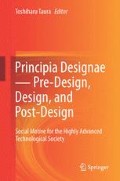Abstract
Thinking quickly overwhelms the mind, and the mind expands into the world. The mind creates a range of cognitive tools to represent thought. Sketches are among the most prevalent and productive ways to make thought visible to self and others and to promote creative thought. Sketches, like diagrams, map the elements and relations of ideas to elements and relations on the page. They entail abstraction and allow ambiguity. Their ambiguity creates possibilities, it allows exploration, inference, and discovery of ideas, some of the reasons they are so useful in design as well as other domains. Objects and the surroundings that provide contexts for objects can also serve as tools for thought. Like sketches, objects and surroundings provide visual feedback, but unlike sketches, objects and environments provide tangible feedback, feedback from interactions with the body as well as the eyes of the user. Whereas design begins with ideas and goals that need embodiment, redesign begins with a specific problem embodied in a person in a place at a time. Solutions often come from reuses of old objects. Problems and reuses of designed products inspire implicit conversations between designers and redesigners.
Access this chapter
Tax calculation will be finalised at checkout
Purchases are for personal use only
References
Bobek E, Tversky B (2014) Creating visual explanations improves learning. In: Bello P, Guarini M, McShane M, Scassellati B (eds) Proceedings of the 36th annual conference of the cognitive science society. Cognitive Science Society, Austin, TX
Fontaine S, Edwards G, Tversky B, Denis M (2005) Expert and non-expert knowledge of loosely structure environments. In: Mark D, Cohn T (eds) Spatial information theory: cognitive and computational foundations. Springer, Berlin
Goldschmidt G (1991) The dialectics of sketching. Creat Res J 4:123–143
Goldschmidt G (1994) On visual design thinking: the vis kids of architecture. Des Stud 15:158–174
Heiser J, Tversky B (2004) Characterizing diagrams produced by individuals and dyads. In: Barkowsky T (ed) Spatial cognition: reasoning, action, interaction. Springer-Verlag, New York, pp 214–223
Heiser J, Tversky B (2006) Arrows in comprehending and producing mechanical diagrams. Cognit Sci 30:581–592
Heiser J, Phan D, Agrawala M, Tversky B, Hanrahan P (2004) Identification and validation of cognitive design principles for automated generation of assembly instructions. In: Proceedings of advanced visual interfaces’04, ACM, pp 311–319
Heiser J, Tversky B, Silverman M (2004) Sketches for and from collaboration. In: Gero JS, Tversky B, Knight T (eds) Visual and spatial reasoning in design III. Key Centre for Design Research, pp 69–78
Kessell A, Tversky B (2007) To forge straight ahead or go round in circles. Poster presented at the meetings of the Psychonomic Society, Long Beach, November
Lynch K (1960) The image of the city. MIT, Cambridge
Nickerson JV, Corter J, Tversky B, Zahner D, Rho YJ (2008) Diagrams as a tool in the design of information systems. In: Gero JS, Goel A (eds) Design computing and cognition ’08. Springer, Dordrecht
Schon DA (1983) The reflective practitioner. Harper Collins, San Francisco
Suwa M, Tversky B (1997) What architects and students perceive in their sketches: a protocol analysis. Des Stud 18:385–403
Suwa M, Tversky B (2003) Constructive perception: a skill for coordinating perception and conception. In: Proceedings of the cognitive science society meetings
Suwa M, Tversky B, Gero J, Purcell T (2001) Seeing into sketches: regrouping parts encourages new interpretations. In: Gero JS, Tversky B, Purcell T (eds) Visual and spatial reasoning in design. Key Centre of Design Computing and Cognition, Sydney, pp 207–219
Taylor HA, Tversky B (1992) Descriptions and depictions of environments. Mem Cogn 20:483–496
Tversky B (2001) Spatial schemas in depictions. In: Gattis M (ed) Spatial schemas and abstract thought. MIT, Cambridge
Tversky B (2011a) Spatial thought, social thought. In: Schubert T, Maass A (eds) Spatial schemas in social thought. Mouton de Gruyter, Berlin
Tversky B (2011b) Visualizations of thought. Top Cogn Sci 3:499–535
Tversky B, Lee PU (1998) How space structures language. In: Freksa C, Habel C, Wender KF (eds) Spatial cognition: an interdisciplinary approach to representation and processing of spatial knowledge. Springer-Verlag, Berlin, pp 157–175
Tversky B, Lee PU (1999) Pictorial and verbal tools for conveying routes. In: Freksa C, Mark DM (eds) Spatial information theory: cognitive and computational foundations of geographic information science. Springer, Berlin, pp 51–64
Tversky B, Suwa M (2009) Thinking with sketches. In: Markman A, Wood L (eds) Tools for innovation. Oxford University Press, Oxford, pp 75–84
Tversky B, Zacks J, Lee PU, Heiser J (2000) Lines, blobs, crosses, and arrows: diagrammatic communication with schematic figures. In: Anderson M, Cheng P, Haarslev V (eds) Theory and application of diagrams. Springer, Berlin, pp 221–230
Tversky B, Agrawala M, Heiser J, Lee PU, Hanrahan P, Phan D, Stolte C, Daniele M-P (2007) Cognitive design principles for generating visualizations. In: Allen G (ed) Applied spatial cognition: from research to cognitive technology. Erlbaum, Mahwah, NJ, pp 53–73
Zacks J, Tversky B (1999) Bars and lines: a study of graphic communication. Mem Cogn 27:1073–1079
Acknowledgements
Gratitude to the following grants for partial support of some of the research: ONR NOOO14-PP-1-O649, N00014011071, and N000140210534, NSF REC-0440103, NSF IIS-0725223, NSF IIS-0855995, and NSF IIS-0905417 and the Stanford Visual Analytics Center.
Author information
Authors and Affiliations
Corresponding author
Editor information
Editors and Affiliations
Rights and permissions
Copyright information
© 2015 Springer Japan
About this chapter
Cite this chapter
Tversky, B. (2015). Affording Design, Affording Redesign. In: Taura, T. (eds) Principia Designae - Pre-Design, Design, and Post-Design. Springer, Tokyo. https://doi.org/10.1007/978-4-431-54403-6_7
Download citation
DOI: https://doi.org/10.1007/978-4-431-54403-6_7
Published:
Publisher Name: Springer, Tokyo
Print ISBN: 978-4-431-54402-9
Online ISBN: 978-4-431-54403-6
eBook Packages: EngineeringEngineering (R0)

